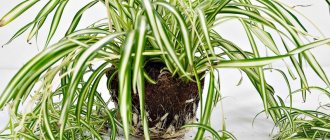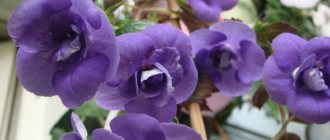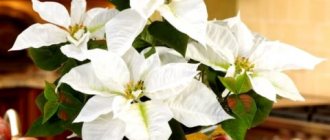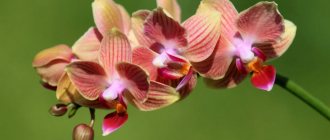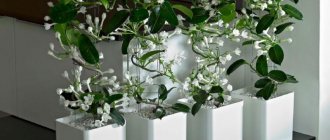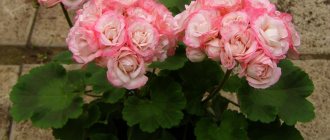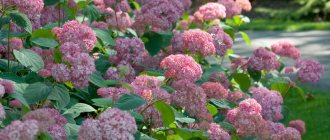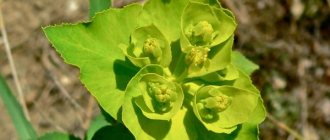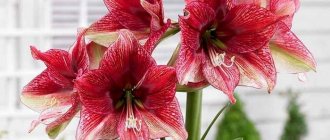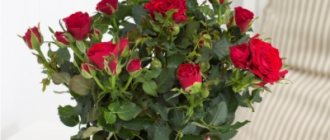Description, history
The flower belongs to the Begoniaceae family of perennial flowers. At the moment, this species has 900 natural, as well as 2000 hybrid varieties. The first mentions begin in 1700. You will learn about the variety of begonia species in this article.
REFERENCE! The biologist who discovered this species was named Michel Begon, and the flower was named after his surname. It was first found in the Antilles, where it was described by a biologist.
How to propagate red leaf begonia
Red leaf begonia is propagated by cuttings or leaves. It is best to do this in the spring. A cutting up to 9 cm long is cut from the root, the cut is slightly dried, treated with “Kornevin” or another similar product, placed in a mixture of sand and peat or in vermiculite, covered with a jar or a transparent bag to create a greenhouse effect. After a couple of weeks of keeping it in a warm, bright room, fertilizers are added to the water for irrigation. After a month, roots usually form, the plant is opened, and watered abundantly.
Several new plants are produced from one leaf. To do this, cuts are made along the veins on the underside, the leaf is placed on damp soil (sand, peat), and pressed tightly. After a few weeks, roots begin to form, and then new sprouts.
Photo
Next you can see a photo of bright red begonia:
See what other types and varieties of begonias look like. We will talk about the following: Tiger, Naked, Emerald, Bolivian, Maple-leaved, Diadem, Blue-leaved, Metallic, Collared and Mason.
Landing requirements
First, let's describe everything in general terms. In principle, planting any ornamental plant is a troublesome task, but when planting our guest, who is also called the “unpretentious foreigner,” it is worth observing strict requirements. When planting begonias, be sure to consider:
- The problem may not be germination due to freezing of the tubers.
- When purchasing, you should pay attention to the presence of rot on the glomerulus.
Small roots can be removed from the tuber. It should be processed in a special liquid. ATTENTION! An excellent preparation for treatment is a fungicide; the proportions for dissolution can be found on the packaging. Processing takes from 20 to 40 minutes. - The pot should not be deep, as the roots will not be long in the future. Drainage must be placed at the bottom of the pot. Drainage should not fill more than 10% of the pot's volume.
- The soil should be loose and also have a large amount of air. You can buy such land in specialized stores. Debris such as pebbles or sticks must be removed. There is no need to crush the soil; the looser it is, the better. It wouldn't hurt to add vermiculite.
- There is no need to deepen the tuber much; relatively speaking, the tuber sits “up to the shoulders.”
- While the begonia is not yet strong, watering is carried out along the edge.
- Do not cover dishes to create excess moisture.
Lighting
Red begonia loves bright and diffused sunlight . You can place the plant in partial shade. But under no circumstances should direct sunlight hit the begonia; it is harmful to it and can lead to the death of the plant.
The soil
The soil, as for all other begonias, should be loose and enriched with various microelements. Peat and black soil can be added to the soil in a one to one ratio. You can purchase the soil at any flower shop, or mix it yourself.
Adult begonia is not particularly picky about the soil, but when planting and germination, the soil should be loose, have a large supply of oxygen, and should also be enriched with minerals and trace elements. Soil is one of the most important factors affecting the beauty of your begonia.
Home care
- The most favorable temperature range is from 13 to 22 degrees Celsius, but do not forget to maintain stable air humidity. The optimal level of air humidity is 60 percent.
- Since our begonia is a herbaceous species, the dormant state lasts from October to February. To transfer the plant to this state, watering is reduced and wilted shoots are cut off.
- Some experts advise storing begonia tubers in the dark at a temperature of 10 to 12 degrees Celsius for up to two months.
- The best growth properties appear when the plant is in partial shade.
- Watering is carried out only after the top layer of soil has completely dried.
- To provide the begonia with the moisture it needs, the pot should be placed on a tray with water, but so that the pot itself is not in the water, or placed on wet peat.
REFERENCE! To prevent the pot from being in water, pebbles are poured onto the tray, or the pot itself is placed on an inverted saucer. If the humidity level is too high, the begonia will rot, so do not overdo it. - On hot summer days, the air around the begonia is sprayed, but so that water does not get on the leaves.
- The room in which the begonia is located must be ventilated periodically, but so that the plant itself is not exposed to a draft.
- Transplantation is performed only in cases of extreme necessity.
Home care
Decorative flowering begonias are undemanding, but, nevertheless, novice gardeners should familiarize themselves with the basic rules and subtleties of winter and summer flower care.
Top dressing
Of particular importance for begonia is regular feeding, which it urgently needs during the period of active flowering - from April to September. During this period, it is recommended to apply liquid fertilizers specially designed for indoor ornamental flowering crops with each watering, approximately once every 10–14 days. The plant responds well to mineral products or organic mixtures, for example, bird droppings or rotted manure. For the described variety of flower, it is better not to overuse nitrogen-containing fertilizers, since they inhibit the development of flowers and activate the growth of greenery.
During the dormant period, which lasts from October to March, you should not apply fertilizers.
Watering
Begonia prefers moderate watering, the need for which is determined by the drying of the top layer of soil - approximately once a week. When watering the plant, you should not allow the soil to become excessively moist, as this can cause rotting of the root system. At the same time, it is not recommended to allow prolonged drought, as the plant may drop its flowers.
In winter, when the flower is dormant, the frequency of irrigation activities should be reduced to once every two weeks.
You may be interested in reading about begonia varieties such as begonia elatior and everflowering begonia.
Trimming
It is impossible to grow a profusely flowering, aesthetically attractive plant without carrying out a mandatory procedure - pruning, which is required for:
- formation of a lush crown and aesthetic form;
- bush rejuvenation;
- improved flowering.
If this stage is ignored, the plant loses its decorative appeal, takes on an unkempt appearance, the flowers become smaller, and the shoots become thinner.
You need to take care of the formation of the crown even at the stage of a young plant. When the begonia reaches a height of 6-7 cm, the top should be cut off, which will activate the development of lateral shoots. As soon as the lateral shoots grow to 10 cm, it is also necessary to trim their tops. In this case, it is important to ensure that the processes are shortened above the bud directed towards the outside.
Subsequent pruning of the crop is recommended to be carried out systematically. To do this, you need to shorten shoots that are too long, remove damaged or dry shoots, and remove dried foliage and inflorescences.
Tuberous begonia species require mandatory pruning for the winter.
Events should be held in October:
- A few weeks before circumcision, reduce the number of moisturizers.
- After the leaves and flowers dry out, cut off the above-ground part of the crop, leaving 1-2 cm on the surface.
- After pruning, the plant is placed in a dry, cool room with stable temperatures no higher than +15°C.
To prevent the flower from completely drying out, during the dormant period it is moistened several times a month.
Transfer
When the root system of a begonia grows, it is recommended to transplant it into a new pot, the diameter of which is 2-3 cm larger than the previous one.
Important! A young plant, up to three years old, must be replanted every year in the spring. An adult flower older than 3-4 years is replanted once every 3-4 years.
The process of replanting a plant is similar to the process of planting it. The flower must be carefully removed from the old container, the root shoots must be thoroughly cleaned of soil residues, and the roots must be treated with a solution of potassium permanganate or any fungicidal preparation. The prepared crop must be planted in a new pot and provided with the proper conditions: temperature, lighting, watering.
Diseases and pests
Begonia is most susceptible to four diseases:
It is a fungal disease caused by a fungus called “Erysiphales”. It develops on leaves and on surface shoots, presenting a white coating, which, due to its location, is quite difficult to detect in the early stages.
Powdery mildew.
The disease leads to drying out and subsequently rotting of the leaves. The fungus can be destroyed by spraying with special preparations.The more common name for fungus is mycelium. If desired, you can grow it yourself on bread.
- Gray rot. Like powdery mildew, it covers begonia with a coating, but this time it is gray-white, or completely gray. This disease can be detected without problems at any stage. Trichodermin can be used as a remedy.
- Bacterial spotting. Interspersed with spots of brown-red or brown color appear on the leaves.
- Ring spot. The appearance of white spots with a clear shape.
Begonia can be affected by the following parasites: spider mites, white moths, and so on. The tick is considered the most annoying, the fight against which is complicated by the fact that it quickly lays larvae. In this regard, the treatment will have to be performed 3-4 times a week, for approximately one to two months.
Important! The optimal solution is powder in ampoules. This product has proven itself very well, especially considering the price/quality ratio.
Checking air humidity
Before purchasing Fimbriata for growing as an indoor flower, make sure that the air in the room is sufficiently humid. For these purposes, you can use a hygrometer, or you can use the following method:
- Fill a glass glass with cold water and place it in the refrigerator.
- As soon as the liquid has cooled to +3 ᵒС, place the glass on the table (away from heating devices) and observe.
Result evaluation:
- the glass fogged up and dried within 5 minutes - the air is dry;
- not dry even after 5 minutes - average humidity 65-85%;
- Streams ran along the walls of the glass - increased air humidity of more than 85%.
Types and characteristics of reproduction
There are many ways to propagate begonias. The method of growing from a nodule was described above, but I would like to add the following features: the tuber has two parts, convex and dented. Contrary to popular belief, the tuber should be planted with the convex part down, and not up, since the sprouts sprout from the dented side. However, in addition to the tuber method, there are many others. About them below.
Vegetative
The vegetative method includes two subtypes:
Reproduction by children. For it, it is necessary to cut off the top of the rhizome no more than 7 and no less than 5 centimeters long. Next, this shoot is placed in the ground, after which it is covered with a plastic bag to create a greenhouse. After 4 weeks, the seedling must sprout, which will mean success.- Tuber division. This method is almost the same as the nodule method, but for it the tuber must be divided into parts, each part must have at least one bud.
Cuttings
Like vegetative, it has two subtypes.
Leafy
This method is necessary when it is necessary to obtain a large amount of planting material. The sheet method is carried out as follows:
- To begin with, select the healthiest leaf.
- Cut it into squares. The squares should not be more than two centimeters.
- Next, these pieces are placed on a substrate containing peat and sand mixed in equal parts.
- Everything is covered with polyethylene film.
- Ideally, after two or three weeks, the petioles should take root; until this moment they cannot be touched, let alone removed the film.
- After the period of three weeks has expired, in case of rooting, you can open the film and ventilate them, but not longer than 30 minutes, and with each ventilation the time is increased.
Stem
- For propagation, a stem with 1-2 buds is selected.
- Next, you need to make a cut under the lower bud, and above the upper one at a distance of 50 millimeters from the bud. If there are leaves on the cuttings, they are cut off in half.
- A shallow hole is made in the substrate into which the cutting is inserted.
- Everything is covered with plastic film and ventilated every 2-3 days. Instead of film, you can use a bottle.
- Rooting usually occurs within 15 to 30 days.
REFERENCE! For cuttings from the same begonia, the rooting period may be different.
To summarize, I would like to say that red begonia is not particularly different from typical representatives of begoniaceae, but this can only be said about the peculiarities of planting, care and reproduction.
However, if we talk about the features of appearance, then this begonia is one of the most unusual. Large red buds can charm absolutely anyone, even those who are not interested in flowers in principle. Growing this begonia will be a joy for both novice and experienced gardeners.
Nowadays, there are many types and varieties of begonia. All of them are charming and are used with great success in ornamental gardening and indoor floriculture. We will tell you about some decorative deciduous and ever-flowering varieties on our website. Read about these varieties: Griffin, Imperial, Fista, Coral, Hogweed, Royal, Cleopatra and Griffith.
Video on the topic
All about the stunningly beautiful plant - begonia. External characteristics, care, reproduction and possible diseases.
Variety of red begonias
The genus of begonias has about two thousand species, among which there are herbs and shrubs with elegant asymmetrical leaves of various shapes and colors, and indoor plants with small or large bright flowers. There are certain species where the main decoration is a large double flower, for which they are grown, achieving ever more lush, long-lasting flowering. And there are decorative deciduous varieties and hybrids, whose leaves of intricate shape or color attract much more attention.
The small size (25 cm tall) Fista begonia has gained enormous popularity among amateurs and designers with the modest habits of an ampelous indoor plant, in which the stem tends to cling to the ground, and the rounded leaves are painted in two colors - red below, green above.
Red-leaved begonia is compact compared to other members of the genus, and it is easier to care for than its flowering relatives. It differs from others in that on a strong creeping emerald green stem, on long cuttings, two-colored leaves grow, approximately 8 to 12 cm wide, and 12 to 15 cm long, with an oblique oval shape. They are not pubescent, without a jagged edge, the glossy surface of the upper side is dark green in color, and the lower side is red or burgundy. Fista blooms with delicate small pink flowers.
Red leaf begonia
Red leaf begonia
Begonia fista
Begonia fista
